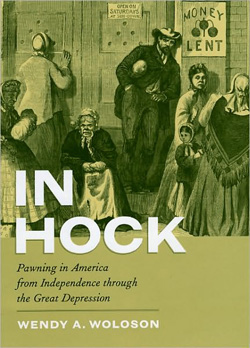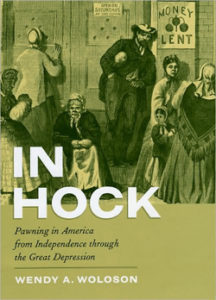Time, Trust and Exchange in the American Pawnshop

Surrounded on all sides by predatory lenders, rapid refund tax shops, and multinational credit card companies “charging interest on interest,” we might stop to notice the lowly pawnbroker. Unlike those other firms, “pawnbrokers provide clear information about loan terms;” they are explicit on “the interest rate and any additional fees being charged, when the loan will come due, and how much money in total is required to retrieve collateral” (186). Nonetheless, the corporate entities which dominate the current landscape of lending and credit enjoy far more social legitimacy than the maligned and stigmatized pawnbroker. In In Hock, Wendy A. Woloson forces us to abandon our misconceptions about the world of pawnbroking, as she provides us with a fully realized and nuanced account of a profession and a set of practices that have “occasionally intersected with, sometimes subverted, and often circumvented wholesale and retail exchange” (3).
Woloson’s well-written book, complete with fascinating image reproductions, is both an economic and a social history of the pawnshop that contains running threads of the history of crime, policing and anti-Semitism in the United States. Both the pawnbroker and the pawner are given the benefit of three-dimensionality, to erase the flat stereotype of the pawnshop as the location where the vice-ridden and the gullible are taken advantage of by the heartless and the parasitic. It is the dismantling and replacement of the crude caricature of the world of pawning and brokering that is the principle ambition of In Hock. Ultimately, Woloson leaves her reader with the understanding that, far from being antagonistic and exploitative transactions, exchanges of objects for short term loans have often been cooperative interactions, rooted in trust between the working poor who were trying to meet their needs, and pawnbrokers who were trying to make a living.
Woloson argues that the negative stereotypes associated with pawnbrokers originated with anti-Semitic attitudes and prejudices. The history of ideas related to loaning money at interest, and the development of money-lending as a Jewish profession, culminate in the despised character of Shylock in Shakespeare’s Merchant of Venice. This “most famous and notorious Jewish character” first appeared on an American stage in 1752 in Virginia. The vulgar depiction of the Jewish money-lender quickly fused with the depiction of the pawnbroker, and throughout the nineteenth century, the pawnbroker was portrayed in novels, newspapers and cartoons as a hook-nosed opportunist. “Works of popular culture had largely succeeded in creating a coherent, seemingly logical stereotype: the pawnbroker had become implicitly the Jewish pawnbroker—the Jew broker—and as Jews and pawnbrokers became increasingly stigmatized, the stereotypes reinforced each other” (37). Despite the popular conception of the pawnbroker as Jewish, Woloson shows that the profession actually included significant numbers of Irish Americans, as well as American-born Protestants.
Regardless of who was engaged in the business, the very nature of the business seemed to contradict the United States’s conception of itself, and thus the broker and the pawner were to remain objects of a derision that went beyond ethnic prejudice. “Pawnbrokers were aliens in a commercial world populated by supposedly moral and upright Christian entrepreneurs, and the very nature of the business set it apart from ‘normal’ economic dealings. The antithesis of merchants, pawnbrokers doled out money instead of taking it in, profiting from customers who lacked capital rather than possessed it” (29). In contrast to the optimism embedded in the purchase of an item from a normal retail store, pawning was viewed as an “aberrant act.” In the world of pawning, “Items that were once indicators of hope, economic vitality, and physical comfort became, as collateral, markers of a downward fall, loss of prospects, alienation” (30). Yet despite the common view of the pawnshop as a perversion of normal economic activity within capitalism, Woloson steadily argues that the pawnshop was a necessary outgrowth of capitalism, and should be “understood as a manifestation of capitalism’s inherent inequalities” (53).
Throughout the book, Woloson offers examples of people who turned to pawning as a means of survival in an economic system that left the working poor unable to meet basic needs such as food and shelter. A material item could be exchanged for cash and a pawn ticket. The loans themselves carried interest rates lower than that which we might encounter with a contemporary credit card company. If the loan along with the interest was repaid on schedule, then the item was “redeemed” to its original owner. If the pawner could not pay the entire loan amount on schedule, then he or she could pay the interest in order to extend the loan and prevent the item from being resold. The pawnbroker’s intention in the transaction was for the item to be redeemed, rather than resold. Woloson argues that pawning was often a rational, manageable transaction, rather than an effort to prolong a gambling or drinking binge, or some other act of desperation. A person might pawn an item to engage in a new business venture, to meet a payroll, or to provide for a family until a crop comes in. According to Woloson, “Artisans’ collateral yielded relatively high loans,” as “Carpenters’ saws, masons’ trowels, and leather workers’ punches found easy conversion into capital during periodic lulls in work, often yielding enough money to tide families over entire seasons of unemployment” (90).
Pawning practices were often seasonal or rhythmic in nature. Customers pawned and redeemed in regular patterns. “Often, women ‘put in’ the family’s Sunday best on Monday morning in order to cover the week’s food and rent, redeeming the clothes Saturday night for the next day’s church services” (94). The pawnbrokers, many of them having been in the business for multiple generations, often built up relationships of trust with their customers, choosing to extend loans even when the items offered for collateral were nearly worthless. Items that went unredeemed were usually funneled by the brokers into secondary and tertiary markets for used goods, ultimately serving to meet the needs of the same poor communities in which the items were originally pawned. “Although pawnbroking played a crucial role in the development of capitalism, it harked back to earlier economies in which economic and social relationships were interlinked” (85).
Perhaps the most commonly pawned item of the nineteenth century was the timepiece. Countless Americans, including Ulysses S. Grant, traded one for a short-term loan at one point or another. Woloson’s writing on the pawning of timepieces, and the interplay between the emergence of the need for keeping track of time under capitalism, together with her characterizations of pawning as a means of “buying time,” amounts to some of the finest and most insightful writing in the book. Less illuminating is Woloson’s exploration of pawnbroking and criminal activity. Nonetheless, she accomplishes her goal of establishing that the pawnbroker was rarely embedded in the criminal economy, and more often than not, the pawnbroker was likely to be the victim of crime, or to be of assistance to the authorities in solving crimes.
The book maintains a focus on the nineteenth century, and in the end, does not explore how pawning changed with the rise of “throwaway culture” in the twentieth century (192). In her conclusion, Woloson leaps to our own time, when ubiquitous credit card companies offer products that are “slick, convenient and wholly anonymous,” and thus “enable a form of borrowing that is pawning’s mirror opposite” (182).
Although Woloson takes the credit card companies and large rent-to-own chains to task, the book stops short of a full-throated critique of capitalism, much less pawnbrokers. At one point Woloson writes of the pawnbrokers’ abilities to appraise items: “Appraising was as much an art as a skill.” Later on the page she defines this “art” as “assigning monetary value to material goods to be used as collateral for loans” (168). Perhaps in this case, Woloson is leaning on a cliché, but the statement indicates a larger ambivalence in the book. At times capitalism is critiqued in defense of pawnbrokers, and at times pawnbrokers are defended as good capitalists.
In all fairness, at no point does Woloson proclaim that she has set out to bring down capitalism by the weight of its own contradictions. Rather she defends a profession and a historical practice that she clearly respects, and she has succeeded in debunking numerous myths and misunderstandings. In Hock will prove to be a useful book for instructors and researchers working in areas such as the history of American material culture, the history of urban poverty and the coping mechanisms of the poor, as well as the history of American anti-Semitism. The book will no doubt also offer some measure of consolation to anybody working in or depending upon the much maligned industry, which Woloson has so thoroughly explored.
This article originally appeared in issue 10.3.5 (May, 2010).
Matthew Vaz is Lecturer of American History at The City College of New York, City University of New York.
